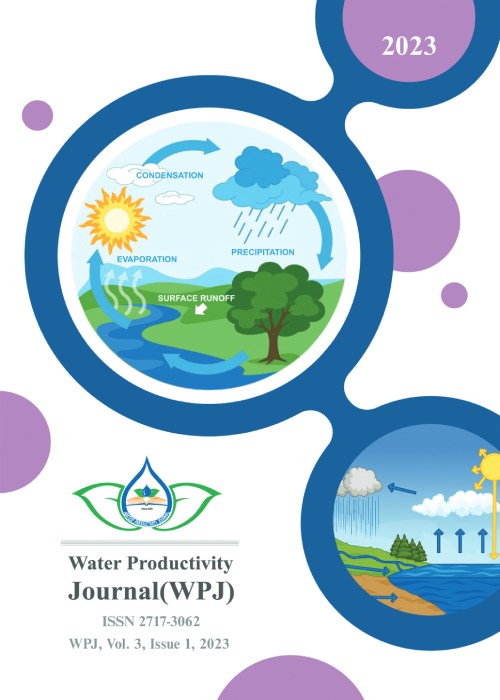Evaluation of rapeseed and barley irrigation management
In this study, irrigation evaluation of different cultivars of Rapeseed and barley in 2017-2018 crop year was performed in Sharifabad farm of Qamroud section of Qom. The result led to optimization of cultivation and improved water productivity is in two products, Brassica napus and barley. The Groundwater EC of this farm is salty. Due to the salinity tolerance threshold of barley, barley was predicted without yield reduction. But in canola crop due to less tolerance to salinity, crop reduction was predicted. During one crop season, Brassica napus was cultivated in eleven cultivars by irrigation method, the planting date started from October 26 to October 17, In tape irrigation, it was irrigated between 10 and 13 times. The objectives of this study were a case comparison between different cultivars of Brassica napus, both foreign and domestic, resistance of cultivars to cold and water consumption and productivity and yield and most importantly a comparison between irrigation methods in terms of water consumption and water efficiency. Meanwhile, Hayola Shirazi cultivar had the highest yield among all cultivars in the type irrigation system with the lowest water consumption.
This climate type is characterized by extremely variable temperature conditions, with annual means decreasing and annual ranges increasing poleward, and relatively little precipitation. This climate is typically located deep within the interiors of continents and is contiguous with the tropical desert climates of North and South America and of central Asia. This region type owes its origins to locations deep within continental interiors, far from the windward coasts and sources of moist, maritime air. Remoteness from sources of water vapor is enhanced in some regions by mountain barriers upwind.The average amount of precipitation for the year in Qom is 12.1" (307.3mm). The month with the most precipitation on average is December with 1.9" (48.3mm) of precipitation. The month with the least precipitation on average is June with an average of 0.1" (2.5mm). There are an average of 71.3 days of precipitation, with the most precipitation occurring in March with 10.5 days and the least precipitation occurring in July with 1.5 days. This research was done in the cropping year of 2018-2019 in one of the endowed lands of the holy threshold of Hazrat Fatemeh Al-Masoomeh located in the northeast of Qom province, Qomrud district. The objective of this study was to compare the water productivity and irrigation management between the two methods of type irrigation and surface irrigation and to compare different rapaseed and barley cultivars at salinity above 8000µmhos/cm.Rapeseed, (Brassica napus var. napus), is a winter or spring annual oil crop in the Brassica family. It is also known as rape and oilseed rape. Archaeological evidence dates barley cultivation to 5000 BCE in Egypt, 2350 BCE in Mesopotamia, 3000 BCE in northwestern Europe, and 1500 BCE in China. Barley was the chief bread plant of the Hebrews, Greeks, and Romans and of much of Europe through the 16th century. Genetic studies suggest that Tibet was an additional, independent centre of domestication for cultivated barley.
Water productiviy is about 0.77kg/m3 was calculated in the type irrigation method with water efficiency of 0.66kg/m3 compared to gravity irrigation (surface) which has a productivity of 0.20kg/m3. In hydroflow irrigation, it performed better than the previous two methods, but consumed more water (about 34.2%) than type irrigation. Regarding barley, it was cultivated in three cultivars and two types of irrigation methods, Fajr 30 cultivar increases water productivity by 2.2 by irrigating the type.
The most important result of this farm operation was that the water efficiency of type irrigation in repseed is more than 2.3 times that of flood irrigation. On the other hand, strip surface irrigation with hydroflume has a higher performance than the other two methods. On the other hand, Hayola Shirazi cultivar consumed about 14.3% less water and was cultivated in terms of planting time about 15 days after the first planting. Hayola Shirazi cultivar has 9% higher yield than the average canola and has the highest yield after Hayola Qom cultivar. But it has been consumed 15% less water than Hiola Qom cultivar. Therefore, due to the quality of water with a salinity of more than 8000 micro mhos per centimeter, local type irrigation for both barley and canola crops has had more than the highest water productivity and efficiency. Barley yield was obtained by irrigating more than ten tons, which is higher than the national average.
- حق عضویت دریافتی صرف حمایت از نشریات عضو و نگهداری، تکمیل و توسعه مگیران میشود.
- پرداخت حق اشتراک و دانلود مقالات اجازه بازنشر آن در سایر رسانههای چاپی و دیجیتال را به کاربر نمیدهد.


